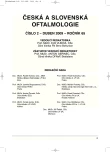European Cataract Outcome Study – Evaluation of 3 Years in European Study
Authors:
A. Slavíková; J. Novák; T. Krejzková
Authors‘ workplace:
Oční oddělení Pardubické krajské nemocnice, a. s., přednosta doc. MUDr. Jan Novák, CSc.
Published in:
Čes. a slov. Oftal., 65, 2009, No. 2, p. 49-52
Overview
Aim:
The aim of this paper is to publish results from the Department of Ophthalmology, Regional hospital Pardubice, Czech Republic, E.U., obtained at our workplace during the period 2003 to 2005 for the all – European study with the title: European Cataract Outcome Study.
Methods:
European Cataract Outcome Study is international all – European study monitoring availability of the cataract surgery in different parts of the Europe and it follows up the quality of the cataract surgeries in separately entered departments.
Its goal is to incite the development of cataract surgery and extend new technologies of cataract surgery and use the findings for determining indication and timing of the surgery for the evaluation of the profit the patients have from cataract surgery. This study evaluates yearly the results of primary cataract surgery provided during one month of the year – October. The study has been proceeding since 1995; we have been participated in it since 2003 and cooperated up to the present day. In the first part of study, there are followed up the basic demographic data with pre – operative investigation and course of the cataract surgery, in the second part results of post – operative investigations during 6 months after the surgery.
Results:
The patients in our department are in entire majority operated in local subconjunctival anesthesia by means of phacoemulsification with implanted foldable lenses, whose number rises along assessed years from 51 % to almost 100 % of cases.
European tendency is out – patient cataract surgery; in our department, there’re patients hospitalized in 60 – 62.9 % of cases. During three years we have noted attendance of associated disorders in 28 - 45 % of cases. The post – operative best-corrected visual acuity 0.5 and better up to 6 months after the surgery is in 86–90 % of cases. The intended postoperative refraction was from -0.40 to -0.48 diopters (dpt), the final post - operative error from the planned refraction was 1.2 dpt. The average of induced astigmatism is 0.61 cylindrical diopters. The ascertained difference between operated and non-operated eye was 0.8–0.9 dpt, after the operation of the fellow eye it was 1.12–1.2dpt.
Conclusion:
Our results are approximately comparable with the condition of the ophthalmologic care in Europe and they correspond to the European average.
Key words:
cataract surgery, European Cataract Outcome Study, surgery improvement, advancement of quality
Sources
1. Lundström, M., Barry, P., Leite, E. et al: 1998 European Cataract Outcome Study. Report from the European Cataract Outcome Study Group. J Cataract Refract Surg., 27, 2001: 1176–1184.
2. Lundström, M., Brege, KG., Florén, I. et al.: Cataract surgery and effectiveness. 1. Variation in costs between different providers of cataract surgery. Acta Ophthalmol Scand 78: 335–339, Medline, ISI.
3. Lundström, M., Brege, KG,, Florén, I. et al.: Impaired visual function following cataract surgery assessed using the Catquest questionnaire. J Cataract Refractive Surg., 26, 2000: 101–108.
4. Nováková, D., Rozsíval, P.: European Cataract Outcome Study – výsledky pětileté účasti. Čes. a slov. Oftal., 60, 2004: 328–334.
5. Oshika T., Amano S., Araie M. et al.: Current trends in cataract and refractive surgery in Japan: 1999 Survey. Jpn J Ophthalmol., 45: 383–387, CrossRef, Medline, ISI, CSA
Labels
OphthalmologyArticle was published in
Czech and Slovak Ophthalmology

2009 Issue 2
Most read in this issue
- Central Serous Choroidopathy as Rare Complication of the Corticosteroid Treatment
- nfluence of Haemorheopheresis in the Dry Form of the Age Related Macular Degeneration
- Septo-optic Dysplasia – Omitted Interdisciplinary Clinic Entity: Report on Three Patients
- Statistical Analysis of the Nerve Fiber Layer in Color Digital Images of the Retina
